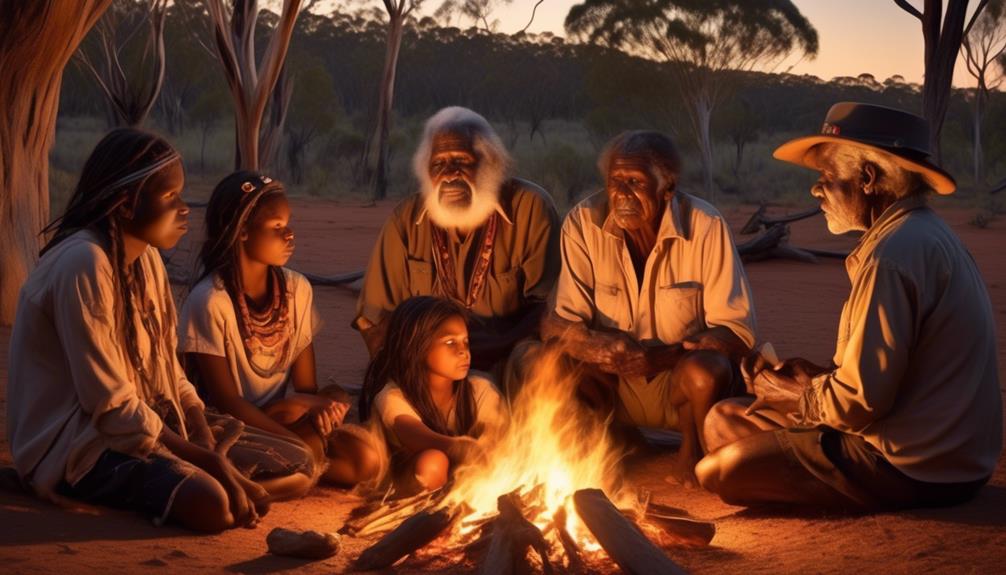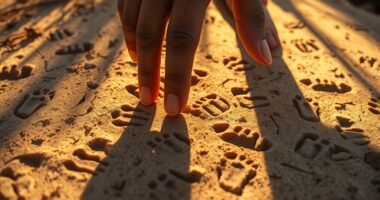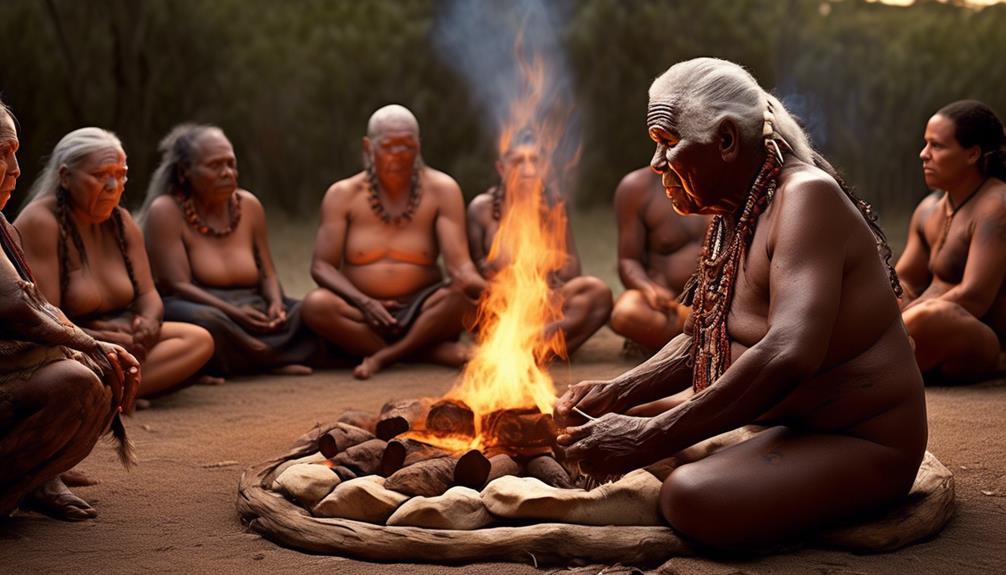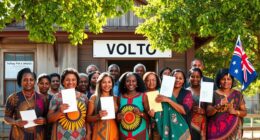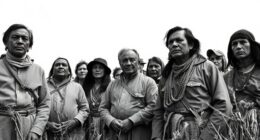We often hear about various cultural influences from around the world, but the unique contributions of Aboriginal Australians are truly unparalleled.
From their traditional land management practices to their rich oral traditions and storytelling, the Aboriginal Australians have a wealth of knowledge and customs that have been passed down through generations.
But what makes their contributions truly stand out are the ways in which they have integrated their cultural heritage into modern society, influencing art, ecology, and preservation efforts.
Key Takeaways
- Aboriginal Australians have traditional land management practices such as controlled burning, which helps reduce destructive wildfires, promote diverse plant growth, prevent invasive species, and protect culturally significant sites.
- Rich oral traditions and storytelling are integral to Aboriginal culture, as they preserve and transmit knowledge, share insights into sustainable land management practices, communicate wisdom and history, nurture respect for the land and its inhabitants, and instill values of harmony and sustainability.
- Aboriginal Australians have unique artistic expressions such as rock paintings, dot paintings, and wood carvings, which reflect cultural storytelling, use patterns, colors, and motifs symbolically, communicate Dreamtime stories and spiritual beliefs, and reinforce the sacred bond with the surroundings.
- Indigenous ecological knowledge among Aboriginal Australians encompasses a holistic understanding of interconnectedness, sustainable land management practices, medicinal plant knowledge for preservation and healthcare, fire management practices for biodiversity and wildfire prevention, and conservation techniques for sustainable resource use.
Traditional Land Management Practices
We will explore the unique traditional land management practices of Aboriginal Australians, which have been integral to the sustainable stewardship of their ancestral lands for millennia. Sustainable practices have been at the core of Aboriginal land management, ensuring that the land remains productive and diverse for future generations.
One of the most well-known practices is fire management. Through controlled burning, Aboriginal Australians have effectively managed the landscape, reducing the risk of large, destructive wildfires and promoting the growth of a variety of plants vital for food, medicine, and other resources. This practice not only maintains the health of the land but also fosters biodiversity, enabling the ecosystem to thrive.
Additionally, fire management plays a crucial role in preventing the spread of invasive species and protecting culturally significant sites. The deep understanding of the land and its natural processes has allowed Aboriginal Australians to develop sustainable practices that aren't only beneficial for the environment but also demonstrate a profound respect for the interconnectedness of all living things.
Rich Oral Traditions and Storytelling
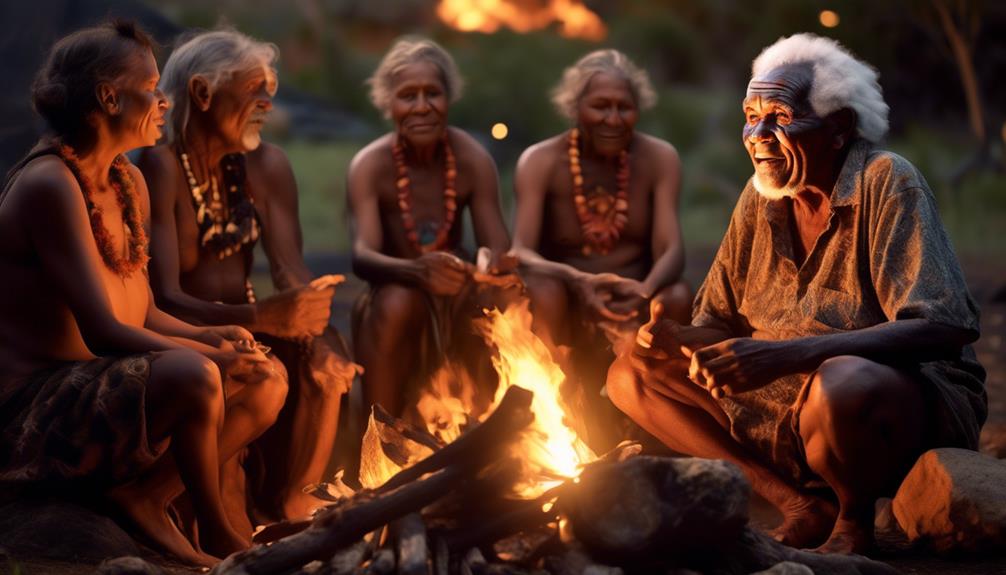
Aboriginal Australians' rich oral traditions and storytelling have been integral to their sustainable land management practices, preserving and passing down knowledge of the land's ecosystems and resources for generations.
The art of oral storytelling is deeply ingrained in our cultural heritage, serving as a means of not only entertainment but also as a way to transmit valuable knowledge, history, and wisdom from one generation to the next.
Through oral storytelling, we share insights into sustainable land management practices, ecological conservation, and our interconnectedness with the environment. Our stories hold the wisdom of our ancestors, offering a profound understanding of the land and its resources, which has been crucial for our community's survival and prosperity.
In our cultural heritage, oral storytelling is a way of nurturing a deep respect for the land and all its inhabitants. It fosters a sense of responsibility and stewardship, emphasizing the importance of preserving the delicate balance of ecosystems.
Through these stories, we impart not just knowledge but also a profound understanding of the interconnectedness of all living beings, instilling values of harmony and sustainability. As we continue to share our oral traditions, we strive to inspire others to cherish and protect the environment for the well-being of future generations.
Unique Artistic Expressions
Embedded within our cultural heritage are unique artistic expressions that reflect our deep connection to the land and our rich spiritual beliefs. Indigenous craftsmanship is a cornerstone of our cultural identity, with traditional art forms such as rock paintings, dot paintings, and intricate wood carvings showcasing the depth of our cultural storytelling. These artistic expressions aren't merely decorative; they serve as a means of passing down our oral traditions and preserving our history for future generations.
Symbolic storytelling is at the heart of Aboriginal artistic expressions, with each pattern, color, and motif holding layers of meaning and wisdom. Through art, we communicate our Dreamtime stories, creation myths, and spiritual beliefs, fostering a sense of unity and connection with our ancestors and the natural world. Our art serves as a visual representation of our interconnectedness with the land, animals, and celestial beings, reinforcing the sacred bond we've with our surroundings.
In preserving and sharing our unique artistic expressions, we invite others to appreciate and learn from our cultural heritage, fostering understanding and respect for the traditions that have shaped our identity for thousands of years.
Indigenous Ecological Knowledge
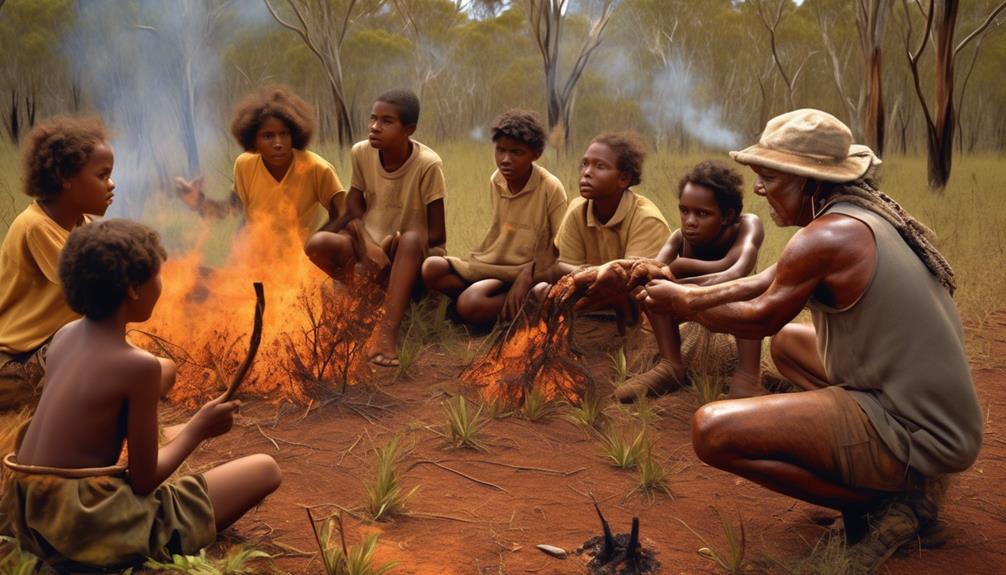
Our rich spiritual beliefs and deep connection to the land have endowed us with a wealth of Indigenous ecological knowledge, essential for understanding the delicate balance of our natural environment. This knowledge has been passed down through generations, providing us with a unique perspective on ecological preservation and sustainable resource management.
- Holistic Understanding: Our Indigenous ecological knowledge encompasses a holistic understanding of the interconnectedness of all living beings and the environment.
- Traditional Land Management: We've developed sustainable land management practices that have sustained our ecosystems for thousands of years.
- Medicinal Plant Knowledge: Our understanding of the medicinal properties of native plants contributes to the preservation of natural resources and provides valuable healthcare solutions.
- Fire Management Practices: Our controlled burning practices not only maintain biodiversity but also reduce the risk of catastrophic wildfires.
- Conservation Techniques: We've developed conservation techniques that ensure the sustainable use of resources, preserving them for future generations.
Our Indigenous ecological knowledge is a testament to our commitment to serving the land and its inhabitants. It offers valuable insights and lessons that can benefit the global community in achieving environmentally sustainable practices.
Cultural Preservation and Revival
Deeply rooted in our traditions, the revival of our cultural practices and heritage is a vital endeavor for the perpetuation of our identity and values.
Cultural festivals play a pivotal role in this preservation, serving as platforms for showcasing traditional art, music, dance, and storytelling. These festivals not only celebrate our rich cultural heritage but also provide an opportunity for the wider community to engage with and learn from our traditions.
Language revival is another crucial aspect of cultural preservation. Through community engagement initiatives, we're working tirelessly to revive and maintain our indigenous languages, ensuring that future generations have the opportunity to connect with their linguistic heritage.
By involving the community in these efforts, we not only foster a sense of belonging and pride but also create a space for intercultural exchange and understanding.
Ultimately, cultural preservation and revival aren't just about safeguarding our traditions; they're about sharing our unique contributions with the world and enriching the broader community through mutual respect and appreciation.
Frequently Asked Questions
How Have Traditional Land Management Practices of Aboriginal Australians Influenced Modern Conservation Efforts?
We've seen how traditional conservation methods of Indigenous land management, rooted in deep respect for the land, have significantly influenced modern conservation efforts.
Their ecological preservation practices and cultural heritage revival have inspired a more holistic approach to land management.
What Are Some Lesser-Known Oral Traditions and Stories of Aboriginal Australians That Have Been Passed Down Through Generations?
We've delved into the lesser-known oral traditions and stories of Aboriginal Australians, which are crucial for cultural preservation. These stories are rich with traditional knowledge and highlight the deep connection to the land.
The oral traditions serve as a guide for environmental conservation, offering insights into sustainable land management practices. It's fascinating to see how these narratives intertwine with the preservation of nature, showcasing the unique contributions of Aboriginal Australians to both culture and conservation.
How Do Aboriginal Australians Use Artistic Expressions to Convey Their Cultural Heritage and Connection to the Land?
Artistic expressions are central to conveying our cultural heritage and deep connection to the land. Through traditional practices, we showcase our rich history and values, emphasizing the importance of conservation and sustainability.
Our oral traditions further enrich the understanding of our land's significance. By intertwining these elements, we aim to serve others by sharing our unique perspective and fostering a greater appreciation for the beauty and depth of Aboriginal Australian culture.
Can You Provide Examples of How Indigenous Ecological Knowledge Has Been Integrated Into Modern Environmental Policies and Practices?
Integrating indigenous knowledge into environmental policy is crucial for conserving our planet. Traditional practices, passed down through oral traditions, offer valuable insights. By embracing these teachings, we're reviving heritage and preserving culture. Aboriginal Australians have contributed unique perspectives on land management, biodiversity, and sustainable living.
Their artistic expressions also convey a deep connection to the land. Incorporating these insights into modern environmental policies enhances our conservation efforts.
What Are Some Specific Efforts Being Made to Preserve and Revive Aspects of Aboriginal Australian Culture That Are at Risk of Being Lost?
Efforts to preserve and revive aspects of Aboriginal Australian culture are ongoing. Cultural preservation involves documenting and sharing traditional practices, languages, and stories.
Reviving indigenous practices includes supporting community-led initiatives, such as land management and traditional food production. These efforts not only safeguard cultural heritage but also contribute to broader understanding and appreciation of indigenous knowledge and practices.
It's crucial to support these endeavors to ensure the continuation of unique cultural contributions.
Conclusion
In conclusion, the unique contributions of the Aboriginal Australians are like vibrant threads woven into the tapestry of our shared history.
Their traditional land management practices, rich oral traditions, unique artistic expressions, indigenous ecological knowledge, and cultural preservation and revival add depth and color to our collective identity.
It's time we recognize and celebrate the invaluable legacy they've left for us, like a symphony of wisdom echoing through the ages.
